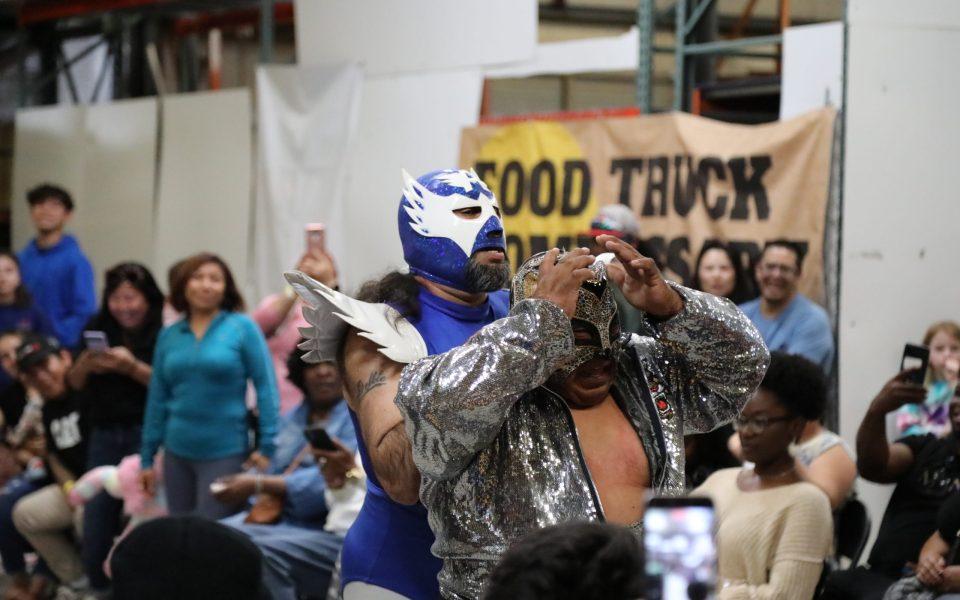Featured photo: Two luchadores fight at Cook’s Flea Market during Vivo Lucha Libre in early March. (photo by Jerry Cooper)
The parking lot that spirals around Cook’s Flea Market is chock full. In this warehouse that sits just north of Winston-Salem, seats are starting to fill up in a small addition that attaches to the main building. The flea market bustles with activity each weekend with vendors that sell…well, everything. The aisles are a vast array of light, sounds and smells that extend into oblivion, selling everything you never thought you wanted. But today isn’t the day for searching through endless boxes of obscure records or buying a bright airbrushed T-shirt that says “God don’t make no trash.” Today is reserved for the ring.
Down a side aisle, in between the tightly packed vendor booths, a pile of multicolored luchador masks sit for sale at a fold-out table helmed by a bored looking young woman tearing tickets. Crashes and shocked screams echo from behind her. The audience inside the cavernous space numbers about 50, half of them school-aged children. They all crowd the wrestling ring situated at the far side of the room and eagerly watch a fox getting clotheslined by a bear. Everyone cheers. It’s the first of five lucha matches scheduled for today’s event.

“Lucha Libre” — literally meaning “Free Fight” — has origins in Latin American cultures, most notably in Mexico. A form of wrestling that eschews the strict rules of Greco-Roman wrestling, lucha libre relies more on acrobatic sport, incorporating high-flying maneuvers, the backstabbing soap-opera narratives of professional wrestling and, of course, the mask.
The lucha mask, a cultural icon in Mexico, has its origins dating back to the Aztecs. Masks were used to symbolize gods and animals, tell histories, and the sacred nature remains true for luchadores. Presently, the lucha mask has attained a worldwide status that celebrates this form of battle. The dedication goes beyond the ring as well.
Mexico’s most famous luchador, El Santo, spent 50 years in the public eye and never removed his mask in public. He was buried in it, in one of the largest funerals in Mexico’s history. To remove an opponent’s mask in a match means disqualification. For one to do so in public is almost sacrilege. The “Mystery Warrior” is part of the charm that adds to the superhero mythos that perpetuates lucha libre. They keep with the classic standards of Good vs. Evil and for every hero, there’s always a villain. Back at the market, Luchador Gato has the crowd favorite Alas de Angel in a sleeper hold while he taunts the crowd relentlessly. Being only the second match, the children in the front row are apoplectic at this betrayal.

“People don’t typically connect literacy with wrestling, but people really underestimate how much children really like wrestling,” says Justus Berger, a local teacher. Berger is the organizer of Vivo Lucha Libre, a local nonprofit that aims to encourage literacy through a series of Luchador wrestling matches. “Getting kids excited about reading, in my opinion, is the most critical thing in education these days,” Berger says.
During the fourth match, wrestler Big Rob’s coach gets into an argument with the referee in the ring. Berger watches Luchador “BIG BITE” pretend to get injured while the ref is occupied. BIG BITE wins on a technicality, and his lucha mask with the huge grinning mouth gapes at the crowd protesting the debacle. A boy about eight looks on in sheer disbelief, his worldview ruined.
“Our goal this year was to buy every first grader in every [local] school Green Eggs and Ham,” Berger says. “We’ve done about five schools so far, about 500-600 books.”
Admission to these events are used to fund book buying and distribution. Berger has also set up a Facebook page for Vivo Lucha Libre and a Gofundme account for Berger’s “The School of Reading” to help areas of low literacy. He plans to distribute 100 books a month.
The final match of the day is a winner-takes-all match between wrestlers Supa Lucha, Don Petty, and Maurice Moss. Moss and Petty have the roles of wild card and heel respectively, and they tear into their parts with enthusiasm. Moss is 17 and has been active in the ring for half a decade already.
“It’s definitely a great platform to reach out to kids and if you have the right gimmicks the kids will follow you through your career,” Moss says. “…it certainly impacted me.”
Petty, 35, relishes his role as the bad guy.
“I’m six-foot-seven, and got some weight on me,” he says. “Letting them see a big man get his tail whupped, if you’re bullied at school or at home, it’s doesn’t matter how big you are. You can always go down.”
Supa Lucha is clearly the fan favorite.
Local Spanish teacher Julie Castante gets into the ring and announces each of the fighters in the final match of the day.
“La ultima pelea de lucha libre está echa para una caída!”

Each fighter hypes the crowd as they enter to their own theme music. Don Petty, with his formidable size, gets the most boos from the crowd as Moss and Supa Lucha each make the mistake of getting within arms length. He subdues each easily, but can’t hold the pin on either. Moss’s agility allows him to slide underneath the ropes and escape certain doom while bringing the fight into the front row. It’s a waltz between the three. Moss and Petty use their combined strength against Supa Lucha and then turn on each other. Lucha catches Petty in the corner and starts giving him the chin music while Moss slips out of the ring to hold Petty before both are thrown out of the ring. The face of a girl in the front row resembles Munch’s The Scream as Supa Lucha defies gravity and vaults over the top rope to fly into the other two as Petty is attempting to throw Moss back into the ring. They pile amid the chairs in the audience. Moss collapses and doesn’t get up. He’s done. Supa Lucha isn’t finished with the now dazed Petty, easily throwing him back into the ring to finish the match. As Petty lies on the mat and tries to regain some control, Supa Lucha climbs the corner of the ring, faces the crowd and backflips onto Petty.
A crowd of 7-year-olds swarm Supa Lucha for a quick picture with him and his belts. Petty and Moss aren’t left out of the adulation either as a kid comes over to sympathize. Supa Lucha is Jay Malachi, an upcoming wrestler who is making waves in the pro-wrestling world, having recently appeared on nationally televised matches and is known for his techniques inside the ring. Supa Lucha sits down on the floor to get on their level as the kids surround him, fawning. His message to them is “Justice and reading 20 minutes a day.” They listen intently and a young girl gives Supa Lucha a hug as a boy beside her tests the weight of one of his belts.
The size of it swamps him.
Vivo Lucha Libre will have wrestling events April 2, May 7, June 4 and July 2 at Cooks Flea Market, 4250 N. Patterson Ave., in Winston-Salem. Event information at facebook.com/vivoluchalibre. Tickets available here.
Join the First Amendment Society, a membership that goes directly to funding TCB‘s newsroom.
We believe that reporting can save the world.
The TCB First Amendment Society recognizes the vital role of a free, unfettered press with a bundling of local experiences designed to build community, and unique engagements with our newsroom that will help you understand, and shape, local journalism’s critical role in uplifting the people in our cities.
All revenue goes directly into the newsroom as reporters’ salaries and freelance commissions.


Leave a Reply